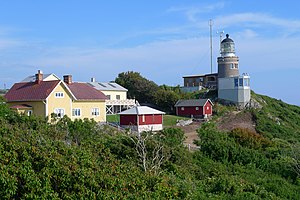Kullens fyr
| Kullens fyr | ||
|---|---|---|
| Place: |
|
|
| Location: | On the Kullaberg | |
| Geographical location: | 56 ° 18 '3.8 " N , 12 ° 27' 5" E | |
| Fire carrier height : | 15 m | |
| Fire height : | 78.5 m | |
|
|
||
| Identifier : | Fl.W.5s | |
| Scope knows: | 27.5 nm (50.9 km ) | |
| Optics: | Fresnel lens | |
| Operating mode: | electric | |
| Function: | Sea fire | |
| Construction time: | 1898-1900 | |
| Operating time: | since 1900 | |
| International ordinal number: | C2260 | |
Kullens fyr is a 15 m high lighthouse in the southern Swedish province of Skåne län . It stands on the north-western tip of the steeply sloping elevation of the same name, the Kullen , at the northern mouth of the Öresund in the municipality of Höganäs , three kilometers northwest of the port city of Mölle . The lighthouse is one of the most prominent landmarks on the Swedish coast and, with its extremely bright (3.43 million candelas ) and far-reaching light, ensures one of the world's most traveled waters ( Kattegat ).
The lighthouse building stands on a steeply sloping headland 67 m above sea level, making it the highest fire height (78.5 m) in Sweden. It was built in 1898 by the Swedish architect Magnus Dahlander from granite and bricks similar to a castle tower in a conical shape. The lantern dome with gallery houses three huge, 2.55 m diameter Fresnel lenses with a total weight of six tons, a construction by the French company Barbier & Barnard from 1900. To stabilize the rotation of the entire lamp-lens system, a 50 Liters of mercury (677 kg) filled container in the base. The initial gas-powered system was electrified as early as 1907. The three Fresnel lenses rotate four times every minute and thus deliver twelve flashes per minute. The 1,000 watt lamp emits a white flash every 5 seconds with a range of 27.6 nautical miles (51 km) (strongest beacon in all of Scandinavia). The lighthouse has been operated automatically since 1979 and remotely controlled and monitored by the Swedish Navy Administration in Norrköping . However, there is still a lighthouse attendant as a special feature . The lighthouse also has a fog horn that sounds twice every 30 seconds in poor visibility. The call ID of the lighthouse is "7S7KUL". The lighthouse has been a listed building as Byggnadsminne since 1935 .
For nearly eight hundred years (possibly earlier) the elevation has been occupied by a beacon. The first of the more modern types dates back to 1561, initiated by King Frederick II of Denmark , the founder of modern lighthouse systems. The famous Danish astronomer Tycho Brahe was given the Falsterbo lighthouse as a fief in 1577 .
Next to the lighthouse is a transmitter for the Differential Global Positioning System .
literature
- Hilmer Carlsson: Fyrväsendets utveckling och de svenska insatserna för fyrteknikens förbättrande . In Årsbok: Föreningens Sveriges sjöfartsmuseum i Stockholm , pp. 31–209; Stockholm 1943.
- Nordisk Familjebok . Nordisk familjeboks förlags aktiebolag, 2nd edition, Stockholm 1904.
Web links
- Kullen. (PDF) Svenska Fyrsällskapet, accessed October 1, 2014 (Swedish).
- Kullens fyr. Retrieved October 1, 2014 (Swedish).
- Entry in the bebyggelseregistret des Riksantikvarieämbetet (Swedish)

